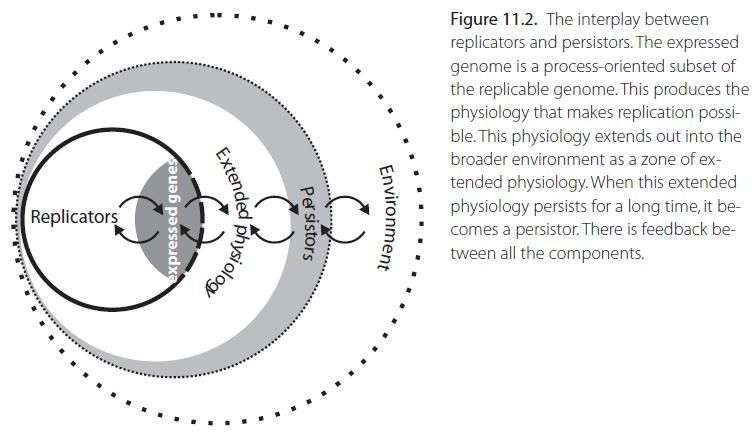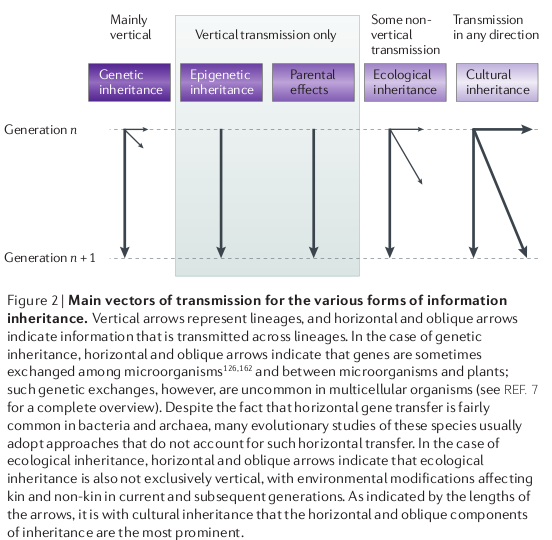Objective
Being a synthesis on epistemology work done during the past years and technological skills unfortunately unleveraged since. See a clarification of the concept OwnConcepts#AlgorithmicEpistemology.
Illustrations  as a follow up of
as a follow up of  (missing the node level)
(missing the node level)
Meta-evolution or the struggle to decide between multiple models (and their mathematical representation) of evolution:
- Darwinian (as generally used in evolutionary computing)
- Lamarckian (as used by Liane M. Gabora)
- structuralist (a la Marcel-Paul Schützenberger)
- "Sandin-ian" (discovered via Biology#metabiology)
- Darwinian/Bernardian (a la Cziko and his mentor or Turner's TheTinkerersAccomplice
 )
)
- others still unknown
whereas it could be a continuity of some of those within specific context cf WithoutNotesFebruary12#BeyondDNA  , determining which one could be helped by (algorithmic) complexity.
, determining which one could be helped by (algorithmic) complexity.
Result
Solve P (with root cause Pr) with T (now economically available) applying M (now socially accepted)
- Solve
difficulty to keep track of fresh aliments with Cucumber gem applying eXtreme Programming. Fabien April 11, 2011, at 11:35 AM
- I1rating:? I1prototype:? ...
Influence the weight of new items e.g. in RSS.
Selection/Evaluation
- Weighting -> Ranking -> Automated testing -> Human testing -> ...
Sources
|
Societal needs
|
Technologies
|
Methodologies/processes
|
|
Expected properties: age, population size, known but non satisfying solutions (economically, politically, socially, ecologically, etc), ...
- Needs (limited and biased since they are personal, yet coherent with Rework)
- ?
|
Expected properties: age, growth, requirements, ...
|
Expected properties: age, requirements, ...
|
Constraints to define for each run
The goal is to more easily, thus cheaply, have a prototype to explore. Constraints can also be called inductive bias or priors.
- years (e.g. restricted to "from 2010 to now")
- field (e.g. restricted to "cognitive science")
- allocated time (e.g. restricted to "1 hour runtime")
- branches to ignore (e.g. restricted to result not requiring "extended cognition")
- or the other way around, branch or branches to require
- leafs to ignore (e.g. restricted to result that are not "Rodney Brooks last paper")
- most likely representing a list of already tried solutions that did not work
Note that the last criteria imply a phylogeny structure.
To consider
- being part of a larger process, thus if as in described in the practice of WithoutNotesJune11#GeneralPrinciplesOfConstraintProgramming it is just a step that facilitate problem solving or foster creativity without itself being the most efficient at producing the final product it would still be a valuable epistemic step
- increasingly costly Seedea:Seedea/InnovationChain#filters
 as the project advances
as the project advances
- remember that one of the initial goal was (and still is!) to directly integrate with rapid prototyping and automated manufacturing in order to have efficient feedback loop and to keep in mind the physical end product
- more than Y and/or less than X results on search engines
- generalist ones e.g. Google, Bing, Yahoo! or meta-search engines like Seeks
- specialized ones e.g. Springer, Google Scholar, LexisNexis or USPTO Web Patent Databases
- Cognition#LayerEpistemicDiffusion
Overall defining the best constraints is where the intelligence and efficiency lay.
Usage
- Terraforming/bootstrapping civilisation
- efficiently and automatically leveraging local resources in new environments with technology checkpoints (e.g. forge)
- software refactoring by suggesting existing libraries
- suggest npm package replacing what’s being typed live
Inspired by
To do
- integrate the economical and sociological equilibrium reached aspect
- meaning that there is no leap or jump, simply matching conditions between what is economically feasible thus available and what was needed
- expansion ability
- a la I:Site/ExtendedSearch#Gradual

- requires either dynamic crawling or established ontology
- e.g. in T consider solely RoR, if nothing satisifying consider web targeting languages in particular then drill down back to NodeJS, etc
- circle visualization
- each resource would be placed around it and the center would serve to represent a combination of multiple resources
- applying the principle of simulated annealing on a repository of phylogeny related to a problem
- WithoutNotesApril11#ChaomeiChen and its CiteSpace software
- ApacheProjects#UIMA annotators for constraints or filters
- OwnConcepts#EpistemotaxisAndRoadmaps for non-yet conducted research
- could be used as supporting structure or attractors or both
- see AWS#NoveltyDiscovery provided list, including list of laboratories and funding per institution sent to Roberto
- see papers based on scientometrics on timescale for prediction of discoveries
- apply recursion
- modification to this page also by the result of its execution
- one could consider the pure randomized model based on previously entered information as an equivalent to "dream" in which memories are shuffled
- it remains highly insufficient for epistemology since no problem solving is involved
- there is no problem defined in the first place to filter out results
- including trimming out impossible branches and tried leafs
- large manipulation (e.g. whole wikis) to try in Testbed:.

- check Sabine Müller's PhD thesis on Cognitive stimulation in computer based idea generation for Virtual Ph.D. Program VGK
Objective
Refresh notions to close the previous yet keep on progressing.
Restrictions
- Improve specs or tests or code' after finishing a reading
- use BDD/TDD/... principle
- thus focus on 1 existing scenario example (rather than saying it could work with anything)
Key domains ordered by importance
- ML
- ReadingNotes/AlgorithmsOfTheIntelligentWeb
- Evolutionary design
- ReadingNotes/TheTinkerersAccomplice
- Computational phylogenies
- http://www.nimbios.org/tutorials/TT_hpc2010
- http://www.med.nyu.edu/rcr/rcr/course/phylo-contents.html
- ?
Meta-phylogeny repository
cf Needs#Cultures
 Fabien Benetou's PIM
Fabien Benetou's PIM









